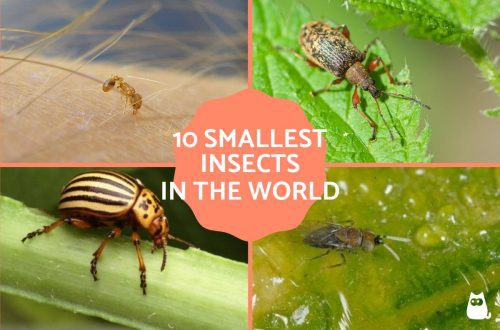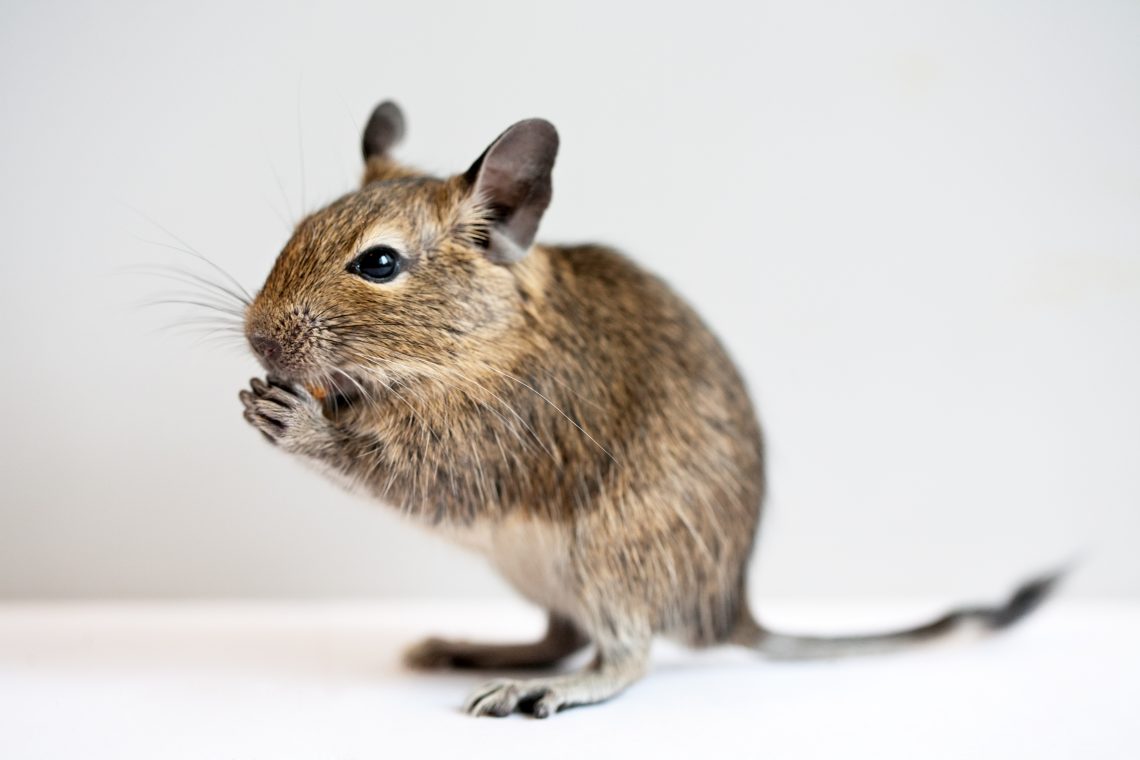
Degu squirrel – care and maintenance: how long does it live at home, what to feed, how to tame and name
Recently, Chilean degu squirrels have come into fashion among lovers of home keeping of rodents. Breeders call them “Degus”, as the official name of the animal sounds like “Octodon Degus”. The popularity of keeping these animals as pets is due to their exoticism, cute appearance and sociability (in comparison with other types of domesticated rodents). Having decided to start a Degu squirrel at home, you need to carefully consider the pros and cons. Like any unusual animal, Degus require special care.
Contents
How the Degu squirrel was domesticated
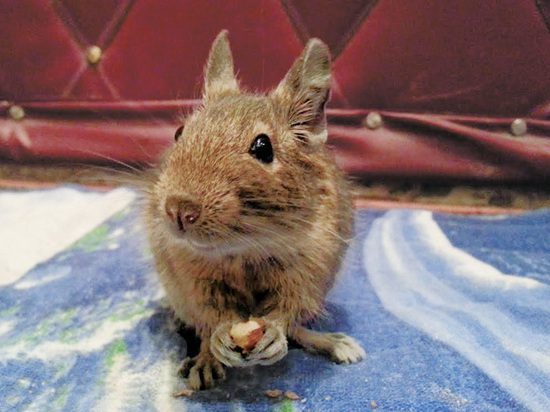
By the modest appearance of the Degu squirrel, you can’t say that it is a pest of agricultural land
“Octodon degus”, the so-called bush rat or Chilean squirrel, was first described in the XNUMXth century. Scientists of that time argued for a long time about the species of the rodent, suggesting that it be attributed either to chinchillas or to rats. In the end, it turned out that the Degus belonged to the genus of sleepy eight-toothed.
Degus, like many rodents, are significant agricultural pests in their natural habitat.. In search of food, they eat plantings, spoil food in warehouses and gnaw at everything that comes in their way.
The Degus first came into human hands as laboratory experimental animals. The species “Octodon Degus” has some unique features – for example, they are one of the few representatives of rodents that are awake mainly during the daytime. In addition, Degus are intolerant of sugar and prone to special changes in the brain, which allowed scientists to model Alzheimer’s disease on animals, conduct research on diabetes, and study the rhythms of day and night.
And only in recent years, Degus have migrated from laboratory cages to pet stores and elite factory nurseries.
Description of the animal
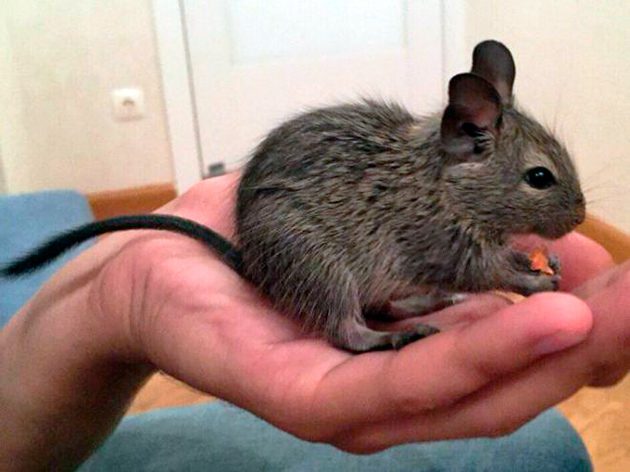
In the wild, Degus try to avoid direct sunlight.
The natural habitat for Degu squirrels are South American rocky areas overgrown with shrubs. Such biotopes can be found in the territories of Bolivia, Chile, Peru and Argentina.
Bush rats are predominantly diurnal, preferring to get food and move around in the morning and evening. This is because direct sunlight and high temperatures can cause them heat stroke.
As herbivores, degus feed mainly on grass, leaves, roots, and bark. The diet also includes a small amount of grains and fresh fruits.. Food is stored in burrows for the winter.
The natural color of Degus is known in two forms: gray-brown and yellow-brown. Artificially, people bred spotted, sandy and blue degus.
Regardless of color, all representatives of the species have the same physique. The length of the body is 10–20 cm, the tail can reach 10 cm and has a tassel at the end. The weight of healthy adults ranges from 100-500 g. Degus have short fur, but soft and pleasant to the touch.
Chilean squirrels have one amazing feature – at the moment of danger they know how to drop their tail. More precisely, they shed the skin from the tail, and bite off the bare area. It is not possible to turn such a trick twice, since the lost part of the tail is not restored.
Like all rodents, Degu teeth grow throughout life, so the animals have to constantly grind them down. A Degu has 20 teeth in total.
Pros and Cons of Keeping a Degu as a Pet
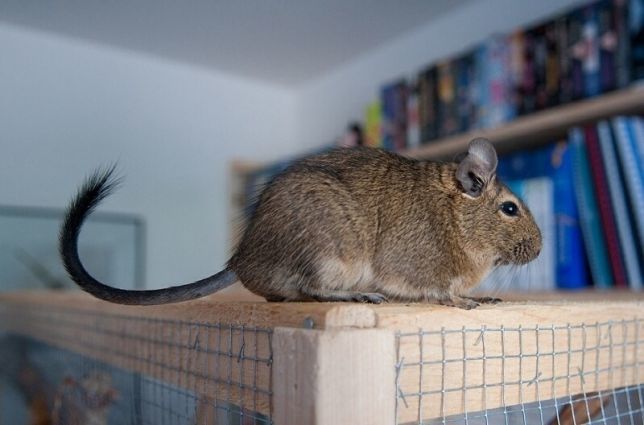
Before getting a pet, and even more so an exotic South American rodent, future owners need to weigh the pros and cons
Only after studying the features of caring for an animal, its habits and possible problems in keeping, a final decision should be made.
Benefits of degu protein content:
- It’s fashionable. Bored ferrets and chinchillas have faded into the background, now South American bush rats are at the peak of popularity;
- Degus take up little space. Unlike dogs or cats, small rodents do not require the space of an entire apartment, they only need a cage of very modest dimensions;
- High intelligence and sociability. Degus breeders claim that their pets have the highest intelligence among rodents. This is a controversial issue, but there is no doubt that domestic Degu squirrels are very sociable and attached to a person;
- Daily lifestyle. Everyone who has experience of keeping rodents at home knows their habit of gnawing the bars of the cage, loudly “talking” and making noise at night. Degus sleep at night and will not disturb their owners;
- Little smell. Degus consume little fluid and also excrete little. The cage needs to be cleaned regularly in any case, but if Chilean squirrels live in it, then this will have to be done much less often.
Negative aspects of Degu content:
- A question of price. Degu squirrel cubs are sold from 500 rubles per head, adults are offered for 1500-2000 rubles. In addition to buying the animal itself, you will have to spend money on equipping the cage with all the necessary accessories, expensive special food and veterinarian care. On average, keeping a pair of squirrels costs the owners at least 2000–3000 rubles a month;
- Noise and rubbish. Despite the diurnal lifestyle, in which domestic Degus do not disturb the owners at night, during the day the pets make a lot of noise and garbage. Therefore, lovers of silence and perfect cleanliness should abandon their idea of having these particular animals;
- An insatiable craving for destruction. Degus are primarily rodents, which means they will destroy and smash everything around that catches their eye. The owners of Chilean squirrels should prepare for the constant replacement of the interior decoration of the cage. If the animal occasionally walks outside the cage, then absolutely all pieces of furniture and household items can suffer.
Home care and maintenance
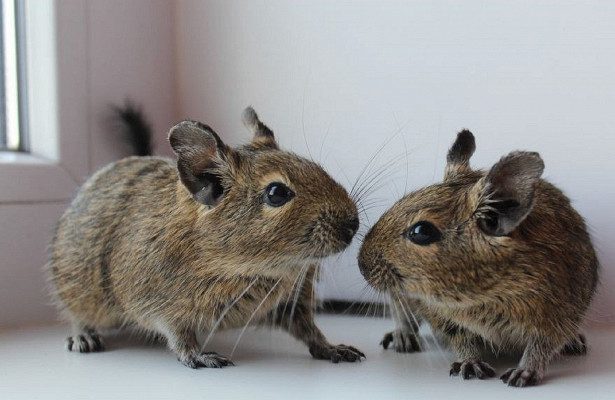
With proper care, Degu will delight you with its playfulness for many years.
In order for the pet to live a long and happy life, delighting the owners with excellent health and mood, he needs to be provided with special care. Like any exotic animal, Degus are quite picky in terms of nutrition: this should also be taken into account when planning to start a rodent.
Never try to pick up a Degu from above or from the side. In the wild, their natural enemies are birds of prey. A rodent can not only drop its tail and lose its external attractiveness, but also die from severe stress. If you want to touch the Chilean squirrel, you must first lure it with a treat and only then gently stroke it.
What to feed
In nature, the diet of Chilean Degus consists of grass, leaves, bark and roots. Sometimes grains and fresh fruits are eaten. It is quite difficult to provide Degus with exactly the same diet at home, since most of the plants eaten by rodents grow only on the South American continent.
But there is an alternative:
- Special purchased feed;
This food can be found in almost any pet store.
Such feed can be ordered online or bought at a pet store. A package of food costs about 500 rubles. It is not recommended to use analogues like rabbit food, as they may contain dried fruits and sugar additives, which are contraindicated for degus.
- Mixes of own production.
The mixture for proper feeding of Degu must necessarily include fresh hay or grass, grains or oat flakes, alfalfa, dandelion leaves and flowers, fruit tree bark, lettuce and dried unsweetened fruits (green sour apples, quince, etc.).
It is better to feed in portions, dividing the daily allowance into 3-5 meals. As a treat, you can treat Degus with rose hips or rowan berries, dry corn or hazelnuts.
Hygiene and bathing
Bush rats are extremely clean. Swimming in the water is strictly prohibited for them, as rodents are prone to colds at the slightest hypothermia.. Instead, Degus take sand baths. Owners should purchase a special bath, for example, designed for chinchillas, and then sift fine, cleaned sand into it, adding a teaspoon of talc or baby powder to it. Such hygiene procedures allow you to remove excess fat from the skin and coat of the animal, which has a positive effect on the health of the degu.
You also need to clean the cage, adhering to the rules. Feces are cleaned at least once a week. Every day, check the nooks and crannies of the cage for hidden remains of wet food (fruits, leaves, etc.) so that it does not ferment or rot. Once a month, it is recommended to carry out a general cleaning, during which the bedding is completely changed, but not entirely, leaving a piece of the same. This is important so that the degus smells familiar.
Diseases and treatment
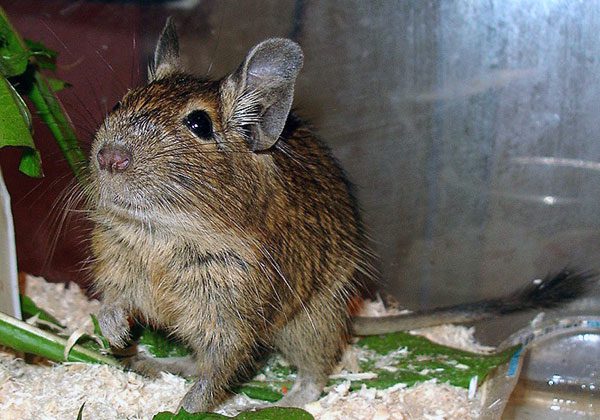
Although nature endowed Degu with good health, rodents are still prone to certain diseases.
Nature has taken good care of Degus and endowed them with good health.. There are not many diseases that these cute animals are prone to. The list contains the most popular of them:
- Diabetes;
Degus are genetically predisposed to this disease. The cause of disorders in the body is most often malnutrition. Remember that Chilean squirrels are strictly forbidden to eat sweet, starchy and many nuts. Signs of diabetes in an animal are manifested in a loss of activity and coordination, as well as a decrease in vision.
There is no medical treatment for rodents. The veterinarian prescribes a special diet and recommends constant monitoring of sugar levels using a glucometer and test strips.
- Cold;
Temperature changes, drafts, swimming – all this can lead to a cold in Degu. A pet with a cold shows quite human symptoms in the form of lethargy and nasal discharge. In addition, the animals have watery eyes, and they may refuse to eat.
Medicines for rodents are not prescribed. Instead of antibiotics, veterinarians advise using traditional means, including washing the mucous membranes, drinking plenty of warm water and rest.
- Baldness;
Hair loss in exotic bush rats can occur for various reasons: due to malnutrition, mechanical abrasion of wool, as a result of allergies, or due to fungal skin lesions.
Treatment is prescribed to eliminate the cause of hair loss. Fortunately, in most cases, baldness is treated quickly enough and without consequences for the rodent.
- Disorder of the digestive tract.
Any veterinarian will insist that nutrition is a very important aspect of a Degus’ life in captivity. Departure from a special herbal “sugar-free” diet can seriously harm the pet, and the digestive organs will be the first to suffer in this case.
Vaccination
In general, rodents and Chilean Degus in particular are not vaccinated.
There are two reasons for this:
- Rodents are not prone to viral and infectious diseases.
- There is no safe and effective vaccine that is suitable for inoculating Degus.
Pet health will help ensure proper care and compliance with the recommendations of veterinarians and experienced breeders for feeding the animal.
Choosing a cage and accessories for the animal
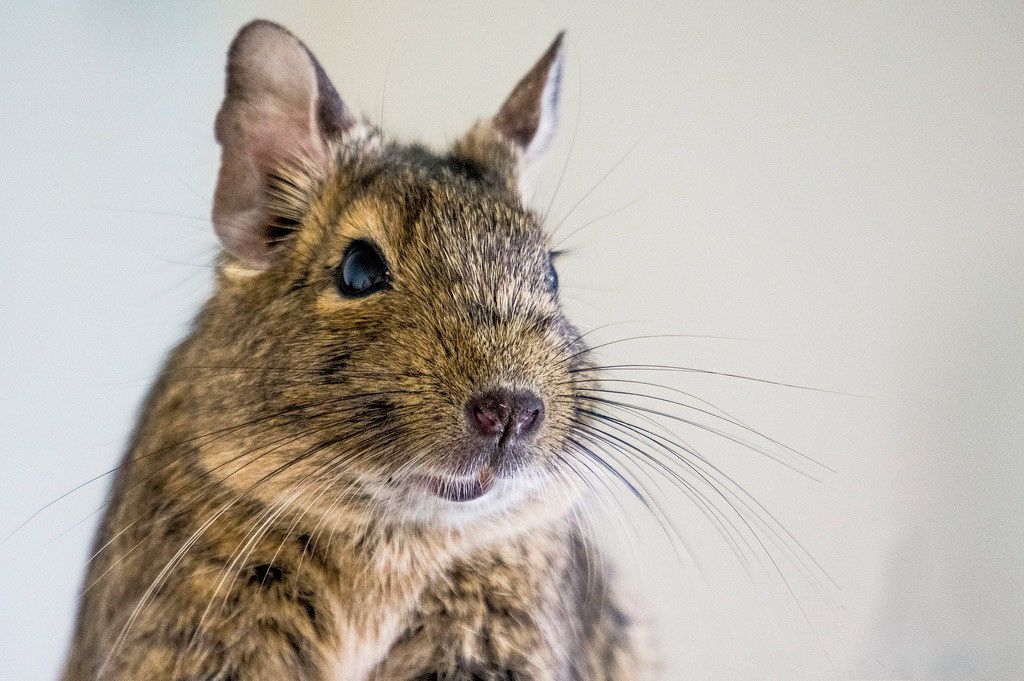
A Degu cage must be sturdy, large and full of accessories.
When choosing a cage and accessories for the Chilean Degu, it should be borne in mind that the surrounding objects only made of durable materials are suitable for rodents.
The optimal housing solution for Degu is a metal cage with sides of at least 70×60 cm and a height of more than 50 cm. It is recommended to install additional tiers and stable ladders in the cage. The system of hanging ropes and tunnels will also appeal to the pet, as they are very mobile and inquisitive by nature.
If you don’t plan to “walk” your new friend outside of the cage every day, then a running wheel is an alternative. For good health and mood, Chilean squirrels need to expend a lot of energy.
The pet house should be made of durable but safe material. A ceramic pot is best (an ordinary unpainted ceramic pot with a chipped edge will do).
In no case should straw or hay be used as bedding, as Degus will try to eat them and may be poisoned by their own secretions. Cat litter and mineral granules are also not suitable: they can damage the delicate skin on the paw pads. An absorbent pad or sawdust is suitable for regular use.
In the cage, it is imperative to install an automatic drinker and feeder. It is not advisable to pour food on the bottom of the cage or on a plate, since the food will immediately be scattered throughout the cage and beyond.
We must not forget about the sand bath tub. The easiest way is to purchase a similar one designed for chinchillas.
In addition to the interior decoration and size of the cage, an important point is its proper placement in the apartment. Degus do not tolerate temperature changes and drafts, direct sunlight and strong odors. It is advisable to protect your pet from other animals and loud sounds.
Breeding
The process of breeding Chilean squirrels is quite troublesome. However, having studied the characteristics of Degu reproduction and providing them with proper care, each owner will be able to get healthy offspring.
When Degus live at home, their reproductive capabilities are slightly reduced, especially for males. Completely healthy individuals that are not related are allowed to mate. Family ties between parents lead to pathologies of pregnancy in females and the birth of sick cubs.
How to determine the sex of a degu squirrel
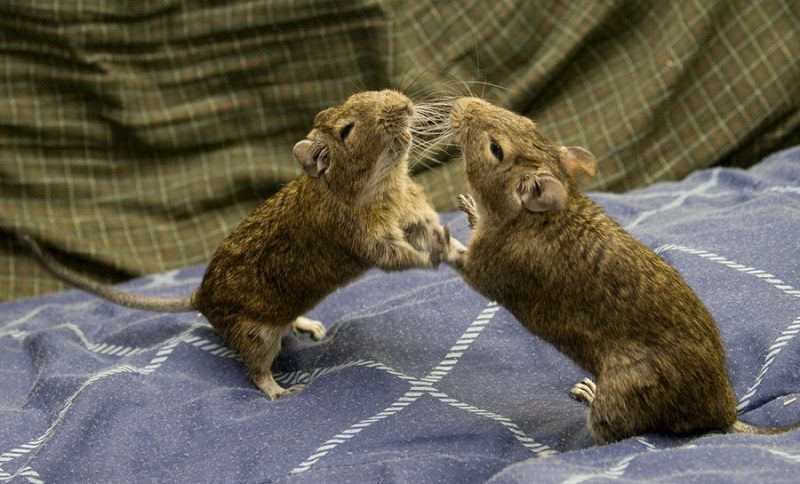
To determine the sex of a Degu, in no case put the animal on its back
There is practically no sexual dimorphism in males and females of Chilean Degus, so it is extremely difficult to determine by appearance whether a boy or a girl is in front of you. This can be done unmistakably only by looking under the tail of the rodents and examining their genitals.
During the “examination” it is not recommended to lay the Degu on its back, since such a position is uncomfortable for the animal, and it can react very aggressively. It is best to simply lift the tail while the pet is addicted to food.
The images below clearly show the difference between a female and a male Chilean squirrel. To determine the distance between the urinary organs and the anus, the little finger is usually used. As can be seen, the distance the size of a finger or more is characteristic of males, while in females this gap is almost imperceptible.
Mating
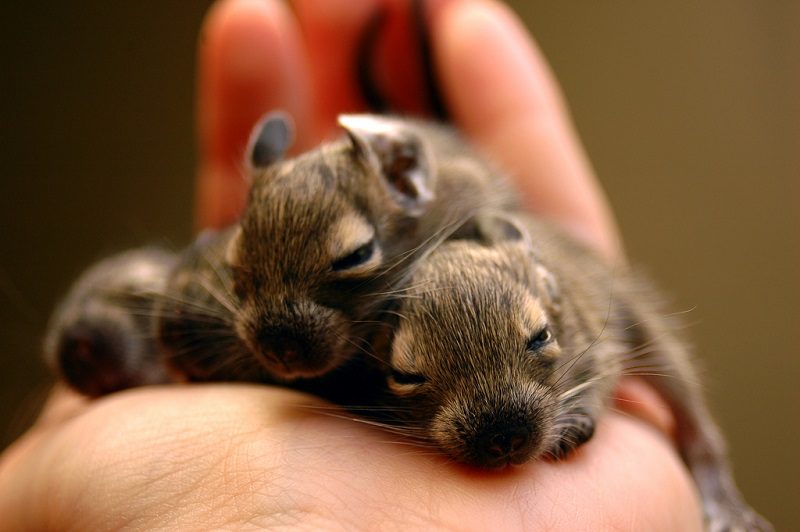
Degus are very selective in mating partners.
Only fully healthy and sexually mature individuals aged from 1 to 5 years and weighing more than 220 g should be allowed to breed.. Female Chilean squirrels are able to become pregnant immediately after giving birth, but in order to successfully feed offspring and bear a new offspring, at least a year must pass between births. That is why the female who has given birth is immediately resettled in a separate cage.
Degu bush rats are picky about choosing a mating partner, therefore, having settled a male and a female for mating in one cage, the owner will have to be patient until the rodents find a common language with each other and are ready to move on to “proximity”.
Pregnancy
Pregnant Degus females carry offspring for three months. You can see the pregnancy with the naked eye by the end of the first month, when the pet’s belly is noticeably rounded, and the movements become awkward.
In each litter, the female brings from 1 to 10 cubs, on average 4-8 babies are born at a time. By the end of pregnancy, it is recommended that the expectant mother be resettled in a separate cage with an equipped “nest”. She will be able to return to her previous conditions as soon as the kids grow up and can eat on their own.
At home, childbirth in Degus is usually difficult, with possible complications. A giving birth female needs human help. Ideally, a veterinarian should take delivery, as in an emergency, special manipulations, injections or a caesarean section may be required..
How to care for newborn animals
A whole handful of tenderness
Newborn Chilean squirrels are born with fur and already open eyes. Cubs grow and develop quickly. After 6 weeks after birth, they become completely independent and can be relocated to separate cages.
The female Degu fully satisfies all the needs of the babies, however, in the event of her death during childbirth, the owner will have to take care of the cubs.
In this case, babies must be fed with a special mixture for newborn kittens, which can be purchased at a veterinary pharmacy. Feeding occurs every two hours, after feeding, babies need to gently massage their bellies. The minimum period for formula feeding is 2 weeks. In addition to regular feeding and massage, little Degus need to be provided with peace and warmth.
Pet training and play
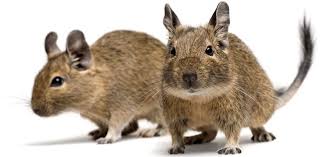
If you devote a lot of time to Degus, they can learn funny tricks.
Degus are highly trainable. To educate rodents, you will need some free time and a delicacy allowed for pets (berries, dry corn, etc.).
Here are some popular tricks that are easy to teach an animal:
- Dance team. Taking a delicacy in your hand, you need to attract the attention of the Degu and rotate it in one direction in a circular motion over the head of the rodent. When Degus performs a dance spin after a treat, you should give him a treat. During training, try to repeat the command “dance” loudly and clearly.
- Command here. Just by luring a rodent with a piece of treat to the right place and repeating the “here” command, you will soon notice that the pet will follow the command already without encouragement.
- Jump command. Having put Degu on one knee and taking the other one aside for a short distance, beckon the animal with a treat on the far knee, loudly repeating the command. When the pet jumps over the distance, reward him by giving him a treat and stroking his ear.
By spending more time with your pet, you will quickly find a common language with him and be able to teach him many tricks and commands..
How long do degus live at home
In their natural habitat, Chilean squirrels live for about 5 years. At home, with proper care – up to 10 years. The life span of a rodent largely depends on diet, hygiene and moderate exercise.
The longest life span of a degu in captivity has been recorded at around 15 years.
How to name the animal
Degus are well suited for funny names with the suffix -ik
When choosing a name for a pet, the owners usually pay attention to the external features of the animal and its characteristic behavioral habits. This is where popular nicknames like “Shustrik”, “Ryzhik”, etc. come from.
Often, owners draw names for pets from movies or books, calling their wards “Bonnie and Clyde” (popular for a couple of Degus), “Rick and Morty”, etc.
Scientists have found that all rodents are better suited to nicknames that begin with the letters Z, C or S. It is these sounds that Degus perceive best, which means that your pets will respond to their name faster.
Video: Degu at home: maintenance and care
Having decided to get a Chilean Degu squirrel at home, be sure to study all the pros and cons of keeping them at home. Exotic animals are quite demanding in terms of care and feeding, which can be an unpleasant surprise for novice degu breeders.
By providing rodents with proper nutrition and care, you will make funny and loyal friends who will be happy to perform simple tricks and go into the hands of their owners.





